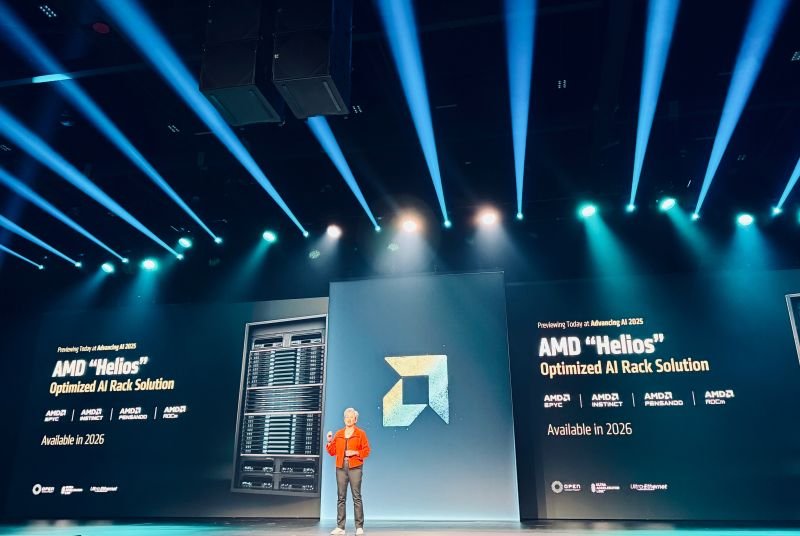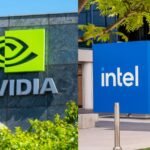In a calculated move to challenge Nvidia’s AI infrastructure dominance, AMD has unveiled its most ambitious AI platform to date—the Helios AI server system, built around its new MI400 GPU family. The announcement, made during AMD’s “Advancing AI” event in San Jose on June 12, comes as OpenAI confirmed it will incorporate AMD’s latest chips into its compute stack.
This marks a significant milestone in AMD’s AI journey, as it not only strengthens its product lineup but also signals growing momentum among hyperscalers seeking alternatives to Nvidia’s closed hardware ecosystems.
Inside the Launch: Helios and the MI400 Series
The headline of AMD’s event was the introduction of the MI400 series, its next-generation data center GPU family, and the new Helios AI server architecture—an open, modular alternative to Nvidia’s tightly integrated DGX and NVL platforms.
Helios System Overview:
- Design: Supports up to 72 MI400 GPUs per rack
- Standards: Uses open networking and industry-standard racks instead of proprietary interconnects like Nvidia’s NVLink
- Target Users: Hyperscalers and enterprises building rack-scale AI deployments
The Helios system is aimed directly at competing with Nvidia’s Blackwell-based systems, such as the NVL72 server design featuring the B200 GPU and Vera Rubin interconnects. AMD is positioning Helios as a more flexible and open alternative, particularly for customers prioritizing interoperability and scalability over vendor lock-in.
OpenAI Partnership: From Customer to Co-Developer
One of the most consequential moments of the event came when OpenAI CEO Sam Altman joined AMD CEO Lisa Su on stage, publicly endorsing the MI400 series and revealing that OpenAI has been testing and providing feedback on AMD’s chips for several months.
Key Points:
- Adoption: OpenAI will use both MI300X and the new MI400/MI450 chips in its infrastructure
- Co-design: OpenAI engineers collaborated with AMD on optimizing memory architecture and token throughput
- Inference & Training: OpenAI plans to use AMD’s GPUs not just for training but also high-efficiency inference workloads
This signals AMD’s rising credibility in the AI hardware race—being selected by OpenAI, a company previously synonymous with Nvidia hardware, is a major validation.
AMD’s Broader AI Chip Ecosystem: MI350 & MI355X
While the MI400 series is the future-facing product, AMD also announced the MI350 series, a high-performance GPU line available from Q3 2024. The MI355X model in particular has garnered attention for its performance-per-dollar metrics.
MI355X Highlights:
- Up to 4× performance boost vs. MI300X
- Memory bandwidth optimized for large language model workloads
- Efficiency: Up to 40% more tokens per dollar compared to Nvidia’s Blackwell B200 GPU, according to AMD internal benchmarks
This mid-generation upgrade gives AMD a near-term competitive foothold, especially among cloud providers and AI startups seeking efficient alternatives to Nvidia’s expensive and supply-constrained chips.
ROCm 7 and Developer Tools
Hardware alone is not enough in the AI arms race, and AMD has made significant strides in its software stack.
ROCm 7 Features:
- Full support for PyTorch and TensorFlow
- Optimization for transformer-based models, including Llama and Falcon
- Kernel libraries tuned for FP8 and BF16 precision—ideal for training large language models
- Easier deployment across cloud and on-prem infrastructure
In addition, AMD launched its Developer Cloud, providing researchers and enterprises with remote access to ROCm-optimized GPU clusters for testing and deployment.
Strategic Acquisitions & Ecosystem Growth
AMD’s AI growth is not limited to silicon. Over the past year, the company has invested in talent and tools to support its platform approach.
Recent Acquisitions and Investments:
- ZT Systems: Enables rack-scale server manufacturing and deployment
- Untether AI: Provides high-efficiency inference accelerators
- Nod.ai, Brium, Silo AI: Strengthen compiler technology and LLM integration
- Lamini partnership: Focused on fine-tuning and serving LLMs on AMD hardware
These moves illustrate AMD’s ambition to become a vertically integrated AI platform provider—from silicon to servers to software.
Market Outlook and Competitive Dynamics
Despite the innovation, investor reaction was mixed. AMD shares dropped about 2% following the announcement, indicating market skepticism over short-term gains in an Nvidia-dominated market.
Still, AMD executives project strong long-term growth:
- $5B in AI chip revenue projected for 2024
- Targeting tens of billions by 2028
- Tapping into a total addressable AI compute market forecasted to hit $500B by 2028
Global hyperscalers including Microsoft, Meta, Oracle, xAI, and Crusoe have already committed to deploying AMD chips, with Crusoe alone investing $400 million in future capacity.
Why It Matters
Open Standards vs Proprietary Ecosystems
By pushing open rack and interconnect designs, AMD is challenging Nvidia’s model of full-stack integration. This could lead to a more competitive and diversified AI infrastructure ecosystem.
Validation from AI Leaders
OpenAI’s adoption of AMD chips represents a breakthrough in credibility. If it becomes standard across OpenAI’s inference and training workloads, it could tip the balance in AMD’s favor for future LLM deployments.
Strategic Depth
Unlike past GPU battles centered only on hardware specs, AMD’s strategy now spans hardware, software, system integration, and customer partnerships—making it a more formidable competitor to Nvidia than ever before.
What’s Next
- Helios and MI400 deployments expected in 2026
- More ROCm adoption across open-source ML communities
- Potential collaborative hardware co-designs with OpenAI and other AI startups
If AMD continues to attract strategic customers while scaling up supply, it could permanently reshape the competitive landscape for AI compute.







